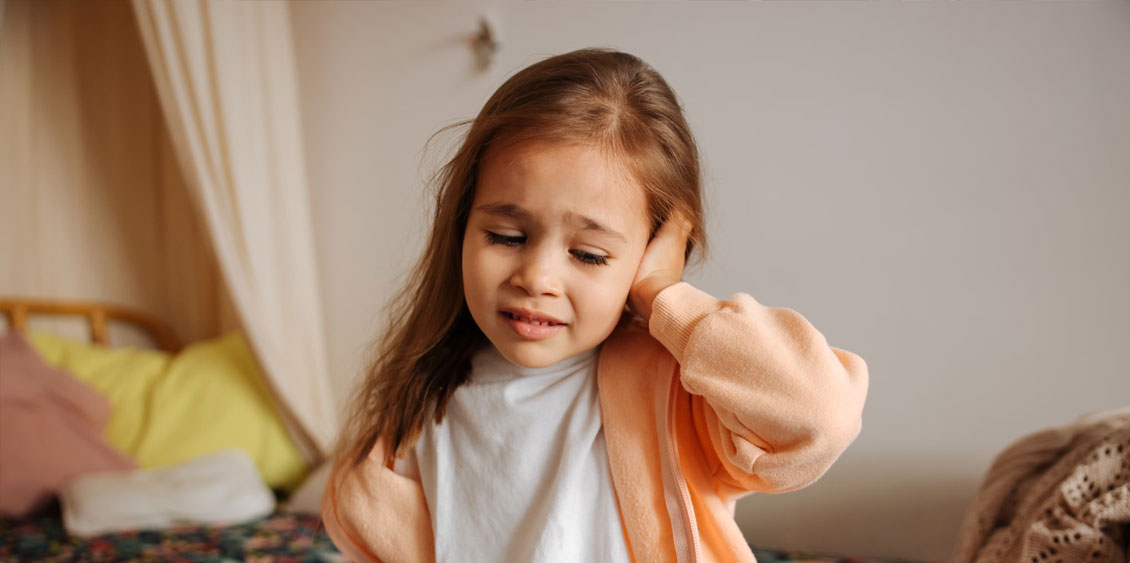Marked by sharp ear pain, fever, and impaired hearing, otitis (ear infection) is a common ailment that can affect anyone, from toddlers to adults. While often benign, ear inflammation can disrupt daily life and, in some cases, lead to complications if not treated properly.
Check out this guide to understanding otitis, relieving it effectively, and preventing recurrences, especially in those most at risk.

What is otitis and what triggers it?
Otitis is an infection or inflammation that affects part of the ear. Although it can occur at any age, otitis affects children more often due to their still-developing immune systems and uniquely shaped Eustachian tubes—fine ducts connecting the middle ear to the back of the nose to evacuate secretions and balance pressure.
Otitis can be caused by the following:
- Infection caused by a virus or bacteria (often following a cold)
- Seasonal or chronic allergies
- Exposure to moisture (especially when swimming)
- Accumulation of earwax
- Sudden changes in pressure (e.g., during air travel or diving)
There are three main types of ear infection, depending on the area affected: otitis externa, otitis media, and otitis interna.
1) Otitis externa
Also known as swimmer’s ear, this condition usually occurs in summer when swimming is more popular. It affects the external auditory canal and often occurs when water stagnates in the ear, creating a humid environment where bacteria or fungi can proliferate. An infection usually manifests as ear pain, itching, feeling as though an ear is blocked, or a slight discharge. Otitis externa can affect one or, more rarely, both ears at the same time.
2) Otitis media
This type of ear infection affects the space behind the eardrum in the middle ear cavity. Common in young children (especially between the ages of 6 months and 3 years), it often follows a cold or respiratory tract infection. Mucus or bacteria can accumulate in the area, causing inflammation, pain, fever, and sometimes even temporary hearing loss. In some cases, otitis media can also cause prolonged discomfort if not treated promptly.
3) Internal otitis
Also known as labyrinthitis, this type of ear infection affects the deep structures of the ear, such as the cochlea and vestibule, organs responsible for hearing and balance. Often viral in origin, it can produce more severe symptoms, including dizziness, nausea, and balance problems. This type of ear infection requires prompt medical evaluation.
How to tell if you have an ear infection Symptoms
Symptoms vary depending on the type of otitis, but there are several common signs:
- Sharp or throbbing pain in the ear
- Fever (especially in children)
- Sensation of having a blocked ear
- Buzzing, tinnitus, or whistling sound in the ear
- Temporary hearing loss
- Ear discharge
- Itching or redness in the ear canal
There are also several signs to watch for in children, including increased irritability, unusual crying, sleep problems, decreased appetite, and frequent ear rubbing.
How to treat an ear infection quickly
When an ear infection is benign and does not require antibiotics, certain measures can help alleviate uncomfortable symptoms:
- Applying a warm or hot compress to the ear
- Resting in a quiet place
- Staying well hydrated
- Resting in a semi-seated position to promote drainage
- Avoiding exposure to wind and cold
Above all, never put cotton buds, oils, or other objects in the ear canal unless advised to do so by your doctor or pharmacist. You could damage the eardrum, increase irritation, and promote infection.
Otitis, earache, and blocked ears: What medications and treatments should you use?
The following over-the-counter medications can be used to reduce pain and fever associated with an ear infection:
- Acetaminophen or ibuprofen for pain relief
- Decongestants or antihistamines if the otitis is linked to nasal congestion or allergies
- Analgesic ear drops (on your doctor’s recommendation and if the eardrum is intact)
It is essential to consult your pharmacist before using any of these products, especially in children or when in doubt about the source of pain.
When should you consult a doctor about an ear infection?
Consult a health care professional as soon as possible if the following symptoms appear:
- Intense pain or pain lasting more than 48 hours
- High fever (over 38.5°C)
- Discharge of liquid or pus from the ear
- Dizziness or balance problems
- Significant or persistent hearing loss
- Recurring symptoms (repeated ear infections)
Should these occur, a medical assessment is recommended. Some ear infections require antibiotic treatment or further follow-up.
How to prevent ear infections in adults and children?
Reduce the risk of otitis by adopting a few simple habits:
- Dry ears thoroughly after swimming and showering
- Avoid using cotton buds to clean ears
- Reduce exposure to second-hand smoke
- Avoid prolonged swimming or swimming in potentially contaminated water
- Treat colds and allergies promptly
- Encourage vaccination, in particular against influenza and pneumococcal infections
- Maintain good nasal hygiene (e.g., nasal irrigation with a saline solution)
Surgery, such as the placement of tympanostomy tubes, may also be considered for children prone to recurrent ear infections. These devices ventilate the middle ear and prevent fluid build-up.
Better prevention and response
Otitis is a common ailment that, while often benign, should be taken seriously. Whether it’s otitis externa after swimming, otitis media following a cold, or the rarer otitis interna, proper treatment and monitoring can prevent complications.
Fortunately, knowing the signs to watch for, responding correctly at home, and consulting a doctor quickly when in doubt can reduce discomfort and avoid repeated infection. Prevention also plays a key role. Simple hygiene practices and a measure of precaution can make all the difference, especially in young children. In case of doubt or persistent symptoms, don’t hesitate to consult your pharmacist. They can help determine appropriate care and recommend treatments adapted to your situation.